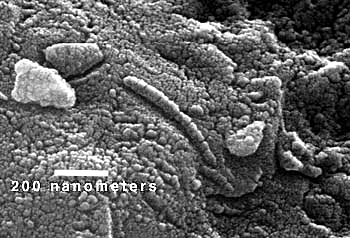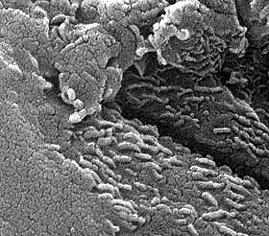|
|
|
|
|
|
|
 by G. Jeffrey Taylor
by G. Jeffrey Taylor
 |
The most stunning evidence for most of us is the presence of tiny, tube-shaped objects that resemble terrestrial microfossils. The one shown here, photographed with an electron microscope, is about 20 nanometers wide (that's only 0.00002 millimeters) and has segments suggestive of filamentous cyanobacteria. Cyanobacteria used to be called blue green algae. They occur as single-cellular or multicellular (filamentous) forms. Bacteria and cyanobacteria are called prokaryotes, which are organisms whose cells do not have a nucleus. Instead, they have a single strand of DNA, strung in a closed loop. (NASA photo.) |
 |
These very tiny fossils were discovered in Western Australia by J. William Schopf (University of California, Los Angeles). A photograph of each specimen appears with an interpretive drawing of the structure. The resemblance to the structures in ALH 84001 [Data link from Meteoritical Database] is quite striking, though those from the Earth are much larger: the scale bar on the photo is in micrometers, rather than nanometers. (Photo courtesy of J. William Schopf.) |
 |
This image shows a large number of microscopic fossil-like objects on ALH 84001 resembling a herd of nanomaggots. Each one is about 10 nanometers long. (NASA Photo.) |
|
|
[ About PSRD |
Archive |
Search |
Subscribe ] [ Glossary | General Resources | Comments | Top of page ] |